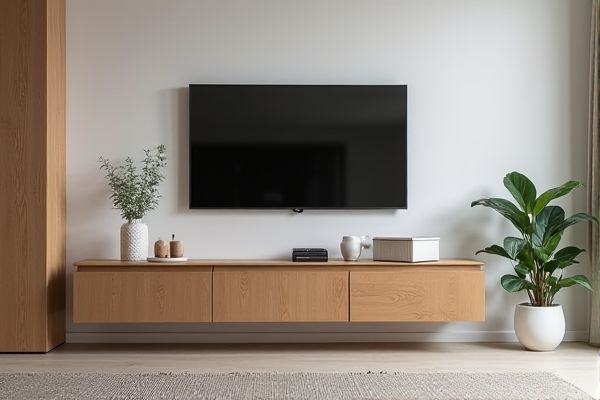
Floating consoles offer versatile placement options and a modern aesthetic by being mounted off the floor, freeing up space and allowing easier cleaning compared to standard consoles that rest directly on the ground. Discover how choosing between floating and standard consoles can enhance Your room's functionality and style by reading the rest of the article.
Table of Comparison
| Feature | Floating Console | Standard Console |
|---|---|---|
| Design | Wall-mounted, space-saving | Floor-standing, traditional |
| Installation | Requires wall support and mounting | Simple, just place on floor |
| Space Usage | Maximizes floor space | Occupies floor area |
| Cleaning | Easy to clean underneath | Difficult to clean under console |
| Style | Modern, minimalist | Classic, bulkier |
| Weight Capacity | Limited by wall strength | Generally higher, stable |
| Price | Usually higher due to installation | Often more affordable |
Introduction to Floating Consoles vs Standard Consoles
Floating consoles offer a sleek, minimalist design that appears to hover on the wall, creating a modern and open aesthetic ideal for maximizing floor space in your living area. Standard consoles, typically grounded and more robust, provide ample storage and surface area for media devices and decor, emphasizing functionality and traditional style. Choosing between floating and standard consoles depends on your spatial needs, design preferences, and desired balance between style and storage.
Design and Aesthetics Comparison
Floating consoles offer a sleek, modern aesthetic by appearing to hover on the wall, creating a minimalist and spacious look that complements contemporary interiors. Standard consoles rest directly on the floor, providing a more traditional and grounded appearance with increased storage capacity beneath. The choice between floating and standard consoles hinges on balancing visual lightness and modernity against practical storage needs and design preferences.
Space Utilization and Room Layout
Floating consoles maximize space utilization by mounting on walls, freeing up valuable floor area and making rooms appear larger and less cluttered. Standard consoles occupy floor space, which may limit furniture arrangement and restrict movement, especially in smaller rooms. Your choice should consider room layout flexibility; floating consoles offer cleaner sightlines and easier cleaning, ideal for compact or modern interiors.
Installation and Maintenance Differences
Floating consoles offer easier installation with wall-mounting brackets that eliminate the need for floor space, contrasting with standard consoles that require floor anchoring and more complex setup. Maintenance of floating consoles is simplified by their elevated design, allowing easier access for cleaning and cable management, whereas standard consoles often involve cumbersome disassembly for upkeep. Your choice between these consoles can impact long-term convenience and space optimization in your setup.
Storage Capacity and Organization
Floating consoles provide versatile storage options with open shelves and drawers that maximize vertical space, ideal for organizing smaller items efficiently. Standard consoles often offer larger enclosed compartments, accommodating bulky electronics and media collections but may require more floor space. Choosing between the two depends on prioritizing compact, accessible storage versus expansive, concealed organization.
Cost and Budget Considerations
Floating consoles generally come with higher installation and material costs due to the need for robust wall support and premium finishes, making them a more expensive option compared to standard consoles. Standard consoles offer budget-friendly choices with simpler installation processes and greater availability of affordable materials. Your decision should weigh these cost differences against design preferences and long-term value.
Customization and Flexibility
Floating consoles offer greater customization and flexibility compared to standard consoles due to their modular design, allowing users to easily add or rearrange components to fit specific workspace needs. Standard consoles typically have fixed layouts and limited options for modification, restricting personalization and adaptability in dynamic environments. By integrating adjustable mounting systems and customizable interfaces, floating consoles enhance ergonomic positioning and workflow efficiency.
Durability and Material Choices
Floating consoles often use engineered wood or MDF with veneers, providing a modern aesthetic but susceptible to moisture damage over time. Standard consoles typically feature solid wood or plywood construction, enhancing durability and resistance to wear and tear in daily use. Your choice depends on whether you prioritize lightweight design or long-lasting material robustness.
Popular Use Cases and Room Types
Floating consoles are ideal for modern living rooms, small apartments, and minimalist spaces, offering streamlined aesthetics and freeing up floor space for easier cleaning and increased mobility. Standard consoles fit well in traditional or larger rooms where storage space is a priority, allowing you to organize media equipment, accessories, and decorative items efficiently. Your choice depends on whether you prefer a sleek, space-saving design or a more substantial piece with ample storage for entertainment setups.
Choosing the Right Console for Your Needs
Floating consoles offer a sleek, wall-mounted design that saves floor space and enhances room aesthetics, ideal for modern, minimalist setups. Standard consoles provide sturdy, freestanding storage solutions with greater capacity for media devices and gaming accessories, suiting larger entertainment areas. Selecting between a floating console and a standard console depends on available space, storage requirements, and the desired interior style.
 homyna.com
homyna.com